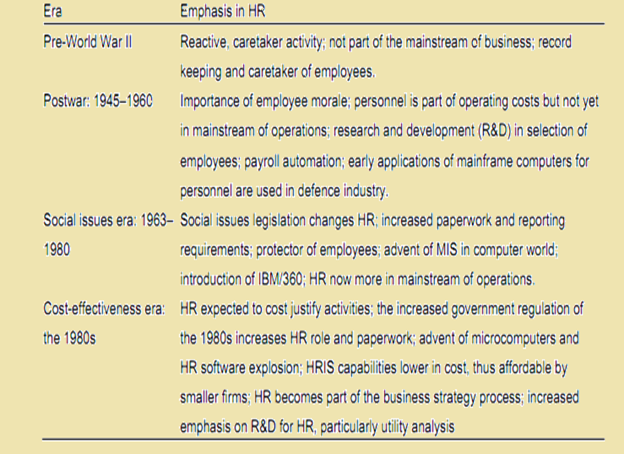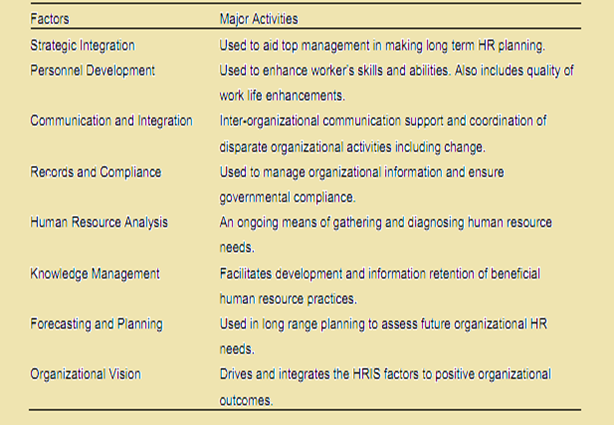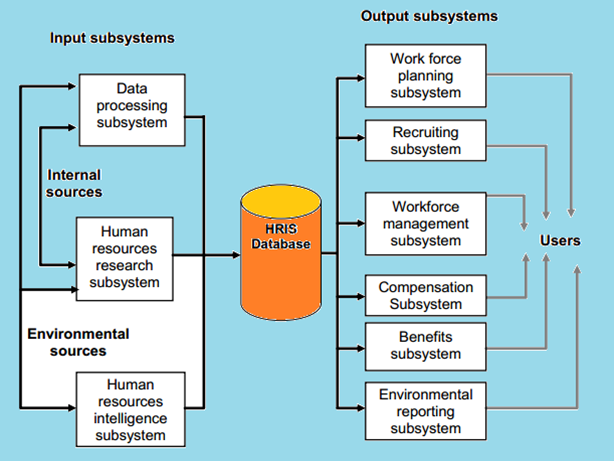Human Resource Information System (Human Resource Management)
Human resource information system comprises of people, forms, procedures and date which is used to gather, store and distribute human resource information. There are bulk of studies in the area of Human resource information system. The Human Resource Information System, briefly known as HRIS is online means for the data entry, data tracking, and data information needs of the Human Resources, payroll, management, and accounting functions within a business. Basically, this system offers management of all employee information, reporting and analysis of employee information, company-related documents such as employee handbooks, emergency evacuation procedures, and safety guidelines. The prime intent of Human resource information system is to provide correct information to take good human resource decisions. This system is adopted to lessen manual work of human resource expertise and help to abandon paper work as all information is stored in database. It also enhances data integrity. With suitable HRIS, Human Resources managers facilitate employees to do their own benefits updates and address changes, thus release human resource staff for more strategic functions.
Academic literature denoted that Human resource information system is an integrated system used to collect, store and analyse information regarding an organization's human resource (Hedrickson, 2003). According to Walker (1982), "The modern Human Resource Information System may be defined as a computer-based method for collecting, storing, maintaining, retrieving, and validating certain data needed by an organization about its employees, applicants, and former employees." Kossek, Young, Gash & Nichol (1994) stated that "the composite of data bases, computer applications, and hardware and software are used to collect/record, store, manage, deliver, present, and manipulate data for Human Resources". Walker (1982) described HRIS as a systematic procedure for collecting, storing, maintaining, retrieving, and validating data needed by an organization about its human resources, personnel activities, and organization unit characteristics. Human resource information system is effectual in today's business environment because they allow employee self-service. In other words, they empower employees to update personal data and address changes without the intervention of HR. This frees up HR staff for more strategic functions. Another reason for using HRIS is that they store data all in one place. This allows time-efficient reporting for compliance, employee development, and strategic means. They can allow executive and management reporting capabilities "on the fly." Managers can access the information in a timely manner as it pertains to employee development, performance improvement, and income details.
HRIS highlight the technical activities to process the data of human resources. HRIS are related to human resource management. Human resource is introduced from six viewpoints to generate a detailed and diverse image of the subject. The viewpoints are: 1) History and background, 2) HRIS and data, 3) Effects of HRIS on organizations, 4) HR and IS professionals and HRIS design, 5) Use and exploitation of HRIS, and 6) HRIS and management work.
The history of HRIS
Historical data have shown that Human resource information system initiates from payroll systems in the decade of 1950s and continues into the 1960s when the first automated employee data was used (Martinsons 1997). Walker (1993) presents how a "true" personnel system was described in the late 1960s. A "true" personnel system has numerous attributes. It is used to solve personnel's needs, not just payrolls. That the system is developed chiefly for the Personnel Department's use, to solve personnel not financial-problems. Secondly, it is multifunctional and in that it addresses user needs in more than one personnel area. Another characteristics of Human resource information system is that it utilizes the five basic concepts underlying human resource systems which include a database with definitions specified for data elements, a method of data update and entry, provisional retrieval techniques, a human resource information centre to assist with administration, a data quality focus.
These concepts bring practise to the development and operation of personnel systems. As objectives, they offer an approach and structure for the work, and they essentially involve procedures, users, and systems professionals. The first personnel systems were made to store a remarkable amount of data for record keeping and reporting related with personnel administration. With time, the development of human resource activities generated the design, development and the effective implementation of various computer-based HRIS (Martinsons 1997). Kavanagh et al. (1990) provided their notion of the development of HRIS introducing the historical eras in human resource from the pre-World War II period to the 1980s and how had been affected the development of Human resource information system. Information technology currently radically changed the human resources function. Providing support for mainly administrative activities such as payroll and attendance management in the beginning, information technology today augments many of the recruitment function's sub processes such as long and short-term candidate attraction, the generation, pre-screening, and processing of applications or the contracting and on boarding of new hires. Online job advertisements on corporate web sites and internet job boards, online CV databases, different forms of electronic applications, applicant management systems, corporate skill databases, and IS supported workflows for the contracting phase are numerous ways by which information systems support recruitment processes (Keim & Weitzel, 2009).
Table 1 Historical eras in HR (Source: Kavanagh et al. 1990, Pp: 7)

In the decade of 1990s, theorists explained how HRIS should have affected an organization's human resource activities and business planning. Studies about advantages of using HRIS and about users of HRIS were executed. An organization was considered competent if it had technology and IS to support HR activities. Also, efficiency of Human resource information system on work and development of HR departments and HR professionals were under debate (Tannenbaum 1990). The main interpretation is that the aim of Human resource information system is to store, manipulate and provide data of employees for the organizational use. Names, addresses, phone numbers, education, training, career development and documents of the personal development discussion are typical employee data in HRIS. Additionally, Human resource information system have been intended to achieve most of the routine HR tasks that help to maintain required human resource knowledge in databases. The data is important for management and to keep the human resource management effective and in real-time order. Therefore, Human resource information system are generally developed for knowledge management of HRM. It is performed to control basic data of personnel, which creates better challenges to a profitable and effective organization.
Effects of HRIS on Organizations
Personnel, software and hardware are used as both investments and costs for companies. Senior management and stakeholders assume the investments to benefit the organization. At the same time the costs should be kept in check. Costs and benefits of the employees and HRIS are highlighted in organization. Developed and refined HRIS reduce overall human resource costs and help to simplify the way the customers, managers and employees access and use HRIS both locally and internationally. But the process of globalization put challenge to Human resource information system. The organization must be acquainted with cultural differences which should be taken into account to develop human resource information system (Stroh et al. 1998). Human resource information system provides management with strategic data recruitment, retention strategies and to merge HRIS data into large-scale corporate strategy (Parry 2010). Using appropriate human resource management, companies can do calculations that have effects on the business as a whole. Such calculations include health-care costs per employee, pay benefits as a percentage of operating expense, cost per hire, return on training, turnover rates and costs, time required to fill certain jobs, return on human capital invested, and human value added (DeSanctis, 1986).
Use and Exploitation of HRIS
In the decade of the 1960s, there was spurt of the growth of computerized HRIS. This led to human resource managers and professionals to spend more time to establish, maintain and utilize HR databases. Earlier, HR managers required a lot of time to identify which employees need certain technical skills, which need supervisory skills or management skills. Currently HRIS are supported by practices which help recognize the needs of training and allow tracking with proper training for employees. HR employees spend less time on daily administrative tasks and have more time on strategic decision making and planning. It is established that advanced technologies provide new possibilities to solve administrative work efficiently. Although HRIS are created for HR professionals, employees and managers should also use the system.
HRIS and Management Work
Initially, Human resource information system have been planned for managerial and HR task. But these lead to ambiguity about the division of labour between managers and HR manager. Managers have been accountable for employee data and therefore they have to update administrative information. HR information system can be designed to use by everyone and it should not be a burden or a loss to anyone.
Table: HRIS functions and major activities" (Source:Mayfield et al. 2003)

There are some steps for effective HRIS system implementation. First of all, configure the HRIS for the company's process and policies. It is important to consider the specific policies and workflows associated with payroll, pay increases and training. Secondly, interface the data with other systems and convert the company's historical data into the new system. This will necessitate organizational preparation and may mean employees have to do things differently. Training will need to be prepared accordingly. Sometimes it is helpful to roll out the system to a small test group first to get feedback on how training should go. Other way to connect the HRIS with existing systems is to develop teams to do various activities of the HRIS, such as ERP, payroll. Often human resource team members find that original data is not latest. This is a good time to get fresh employee data from the employees. Next step is to prepare for the system, including budgeting time and money for implementation, training, and communications. Enormous time, energy and money is required into implementing a HRIS. During this time, many problems and stress can arise since drastic changes occur before, during, and after a HRIS is implemented.
Fundamentally, human resource information system is executed at different levels which include publishing of information, the automation of transaction and transforming of whole working of human resource department. These process add value to organization and escalate profit. Ngai and Wat (2006) conducted a survey of the implementation of HRIS in Hong Kong organizations, and found that the advantage of the implementation of HRIS were the quick response and access to information that it brought, while main obstacle was the inadequate financial support. In current workplace, an HRIS is amalgam of different types of information systems. Two variables, human resource philosophy and desired employee contributions has significant role in organizational choices regarding the types of human resource policies used to manage employees across organizations (Lepak, Marrone & Takeuchi, 2004). The contemporary HRIS includes functions of transaction processing systems, communication systems, decision support systems, and some elements of artificial intelligence. The initial step in the design of an HRIS is to identify the requirements of the system. This includes understanding of the target users, data to collect, amount of data to collect, and how often to collect the data. Another step is the business system design. This step resolves issues concerning who will utilize the system, how will it be accessed, and how will it be updated. A combined HRIS is one that contains a comprehensive set of human resource functions. The integration of these functions enables an organization to use the system to access data to make decisions. In the preliminary phase of designing HR systems, they are sometimes sacrificed for short-term cost savings (Treen, 2001).
An HRIS can facilitate job placement positions by containing all the data pertaining to the job description, compensation, training requirements, and existing employee appraisals. Theoretical studies have shown that Human resource information system comprises of three major functions which include Input, data maintenance, and output. In the input function, the information concerning the personnel is entered into the system. This can be done via data entry or by newer methods such as scanning from original documents. The scanning technology permits even signatures and handwritten notes to be entered. The data maintenance function updates and adds new data to the database. Finally, the output function produces information that is presented in a valuable format (Bsat and Beckers, 2002). It has been emphasized by scholars that the selection of an HRIS is important to an organization because the organization will usually adopt the system for a period of at least eight years. The selection process can last from three to nine months. The organization can hire a professional to recommend a system or the organization can purchase existing software such as SAP or PeopleSoft.

Major challenges
In modern human resource information system, major challenge is lack of strategic or operational functionality. Inadequate integration with other systems within the organization, the complication of the system, inflexibility, and the lack of a user-friendly interface also create problems. Organization's senior management must communicate the need to implement new systems. Also, people resist the implementation because they are involved in the development of new business strategies, solutions, and plans (Horney & Ruddle, 1998). It is recommended that management must get employees involved, which will strengthen acceptance and use. Other issues of Human Resource Information System are training of the users to use HRIS, Cost to purchase and implementation of HRIS, time to adapt the HRIS, lack of functional expertise in designing .and improper vendor may provide illegal copy of HRIS.
To summarize, Human resource information system is an effective promoter to incorporate human resource management and Information Technology. HRIS is a system that support human resource functional applications such as employee selection and placement, payroll, pension and benefits management, intake and training projections. Human resource information system support planning, administration, decision-making, and control. These information systems boost administrative productivity and improve decision-making (Gerardine DeSanctis, 1986). The configuration of Human resource information system includes input, maintenance, and output. Input function enters personnel information into the HRIS. The three major groups that use system of Human resource information system are human resource professionals, managers in functional areas, and employees. HRIS enable efficacy and ensure competitiveness among companies. Human resource information system permits an agency for instant access to employee records and augments reporting functionality and providing managers timely information to make important human resources decisions.

